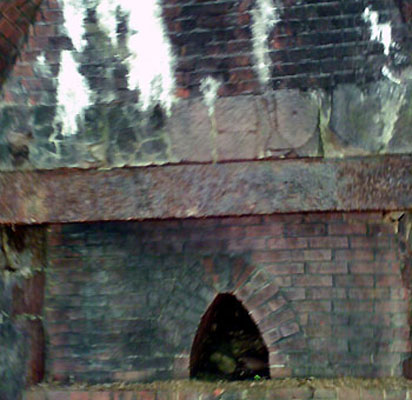Lonaconing, Allegany County, Maryland - www.lonaconing.org
|
History Exhibit Information - Visitor and Tourist Attraction - Tourist and Visitor Information |
 Iron Furnace
Iron Furnace
Main Street
Lonaconing, Maryland
| Restoration Newsletter
|
 Built in 1839, the furnace was shut down in 1856. From the hardened slag deposits at the front of the hearth it appears the drain ports were left open and simply allowed to drain dry. The machinery and air heating furnaces were removed, probably for their resale value, and the wooden scale house and cupola at the time went for firewood and other uses. The area coal continued to be mined, but the basic furnace structure was left intact.
Built in 1839, the furnace was shut down in 1856. From the hardened slag deposits at the front of the hearth it appears the drain ports were left open and simply allowed to drain dry. The machinery and air heating furnaces were removed, probably for their resale value, and the wooden scale house and cupola at the time went for firewood and other uses. The area coal continued to be mined, but the basic furnace structure was left intact.
The town of Lonaconing continued to grow up around it, obscuring the roads and mining rails -- the surrounding land being used for farming and grazing. In time, a high school was built in front of it, cutting it off entirely from the road -- now state highway route 36
For the 1976 ISA bicentennial, the area surrounding the furnace was refurbished into a city park and some preventive maintenance done to the stone structure. A hundred seventy five years of wreathing, has taken its toll, but a few year ago some basic preventive maintenance was again done to stabilize the structure.
A proposal to construct a new town hall on town property adjacent to the park is under consideration. Possibly, a visitors' information center will be included in the new structure. |
(Click pictures for a different view.)
 |
Water is a danger to a structure such as the Furnace -- and in a countryside of brooks and springs, fogs and condensation, water is always present. While damp does not harm the basic building stone of the structure, the home-made brick held in place with home-made mortar which comprises the interior structure is very susceptible. The uncoated wrought iron beams and rods which reinforce the construction are easily rusted by both outside weather and internal underground water seepage.
Crevices in the stonework accumulate dirt, and the dirt accumulates plants whose roots expand and increase the crack size. Both the stone furnace structure and the hillside retaining walls have been damaged by natural weed growth and the roots of small bushes and trees.
The vegetation has been removed and the cracks sealed to minimize further week growth. |
 |
The principal sidewalk through the park and the single staircase which leads to the upper terrace upon which the furnace rests have deteriorated over the years from mortar degradation and water-drive ground shift.
The stairs have been rebuilt but lack of a handrail makes assent difficult. The chambers and inner corridors are open for touring, except the back chamber which has become rubble filled, probably due to water-induced failure of the brickwork which allowed fill-rubble from the bridge structure to tumble into the chamber. It is a matter of historical significance as to whether the rubble should be cleared away and the area open for touring. |
| Ground water leaking from hill-side springs has shifted the earth and caused damage to the retaining walls on either side of the furnace. The excess water makes the terrace too wet to easily walk upon, particularly in the two bays which once housed the air compression and air heat equipment.
The retaining walls have been repaired, and water collection piping has been buried in the two bays to carry the groundwater out of the terrace area and onto the park lawn. |
 |
| Rain water leaking in from the top of the structure has caused the white crystal growth on the ceiling of the chambers. 170 year old, hand made mortar loses lime in the form of calcium salts. The calcium salt laden water leaks into the chambers and forms chalk deposits - while unsightly, primarily they are an indication of the degradation of the interior brickwork of the chimney and firebox. |
 |
 |
To minimize the rain water damage, a concrete cap was applied over the broken and weed-invested flagstone top - a compromise between historical accuracy and pragmatic stabilization. The structure stonework was coated with a water-repellent to further protect the furnace.
Suggestions for further work vary from the small (terrace access ramp, rubble removal, spotlight style-lighting) to the very expensive (a comprehensive dome, climate controlled.) As the last intact furnace of its kind - not to mention one of the first commercially viable - it is much more than just a road-side historical marker. |
And Thank You to --
- National Register of Historical Places for its recognition of the Lonaconing Iron Furnace as an important historical artifact.
- Maryland state government for funding for the most recent refurbishment and structural stabilization of the Iron Furnace.
- Town of Lonaconing for the upkeep, general maintenance, and security of Iron Furnace area.
- the area volunteers who arrange and put on the various tours and general events at the Park.
- the private donors whose generous contributions make the various public events possible.
- the George's Creek Promotion Council, the bookkeeping organization for the donations to the Lonaconing Iron Furnace.
George's Creek Promotion Council, POB 93, Lonaconing, MD 21539
PUBLISHER'S NOTE: This information is published as a public service and is acquired from many sources -- accuracy cannot be guaranteed; please use all Internet-derived information with caution.
copyright 2023 - RK&A, Lonaconing, Maryland - rka@midatlantic.cc
|